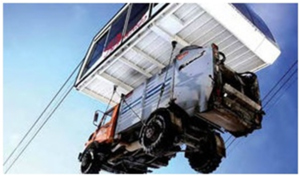Project
The cable car from the valley floor in Wallis to Bettmeralp at 1933 meters above sea level is the “umbilical cord” for this popular vacation destination: Skiers, hikers, and locals use it for transportation since Bettmeralp is car-free. Groceries, building materials, and heating oil are brought up from the valley and trash is brought down, see figure. Just imagine what  would happen if the cable car failed. That is why a second, independent drive and a new controller were installed in 1992. In spite of excellent reliability, it was becoming increasingly difficult to find spare parts. Moreover, converter efficiency could not achieve the efficiency of today’s drives. A modern asynchronous motor in combination with a frequency converter is approximately 25 percent more efficient. Consequently, the Bettmeralp cable cars decided to replace the drives along with the controllers. Sisag of Altdorf supplied the controllers and Beat Bossi, Technology Director, said: “The main difference compared to industrial applications is the high demands on personal safety: The cars of the aerial tramway travel at 8 meters per second. They have to brake in good time before arriving at the stations!” A so-called film lab is used to control and monitor the velocity.
would happen if the cable car failed. That is why a second, independent drive and a new controller were installed in 1992. In spite of excellent reliability, it was becoming increasingly difficult to find spare parts. Moreover, converter efficiency could not achieve the efficiency of today’s drives. A modern asynchronous motor in combination with a frequency converter is approximately 25 percent more efficient. Consequently, the Bettmeralp cable cars decided to replace the drives along with the controllers. Sisag of Altdorf supplied the controllers and Beat Bossi, Technology Director, said: “The main difference compared to industrial applications is the high demands on personal safety: The cars of the aerial tramway travel at 8 meters per second. They have to brake in good time before arriving at the stations!” A so-called film lab is used to control and monitor the velocity.
Solution
“We decided to use a fail-safe controller and chose a Siemens product because it offers the greatest modularity in the safety area as well as a large selection of decentralized devices”, said Bossi.
The S7-300F monitors the setpoint and the effective velocity with the values of various sensors that are attached to the motor shaft or monitor the cable velocity directly. A PROFIBUS connection ensures the communication between the system controller, monitoring, and visualization. Sensors and actuators are linked using fail-safe input/output nodes. The controller and safety controller communicate with the decentralized modules in the bottom station via an optical link. If the car is traveling too fast, the safety controller initiates a braking operation – first via the normal operating brake located between the motor and gearbox. If the car does not slow down, because of a broken drive shaft, for example, the safety brake is activated and acts directly on the large driving pulley that the cable runs on. Because the car cannot be stopped abruptly but rather must be decelerated continuously, the safety controller monitors the operation. The analog values are compared with a defined ramp, which requires a lot of computing power. Besides the operating data, various other sensors are monitored. If, for example, the locking brake or an Emergency Off switch in the car is actuated, the motor must be stopped immediately and the aerial tramway braked. An inductive telecontrol system is used for this, whose function is also monitored by the fail-safe PLC.
Conclusion
When the cable car is carrying 125 vacationers up to Bettmeralp, safety is of utmost importance. The cable car is therefore monitored by a fail-safe controller that has been modernized together with the drives and main controllers. PROFIBUS ensures reliable communication.
